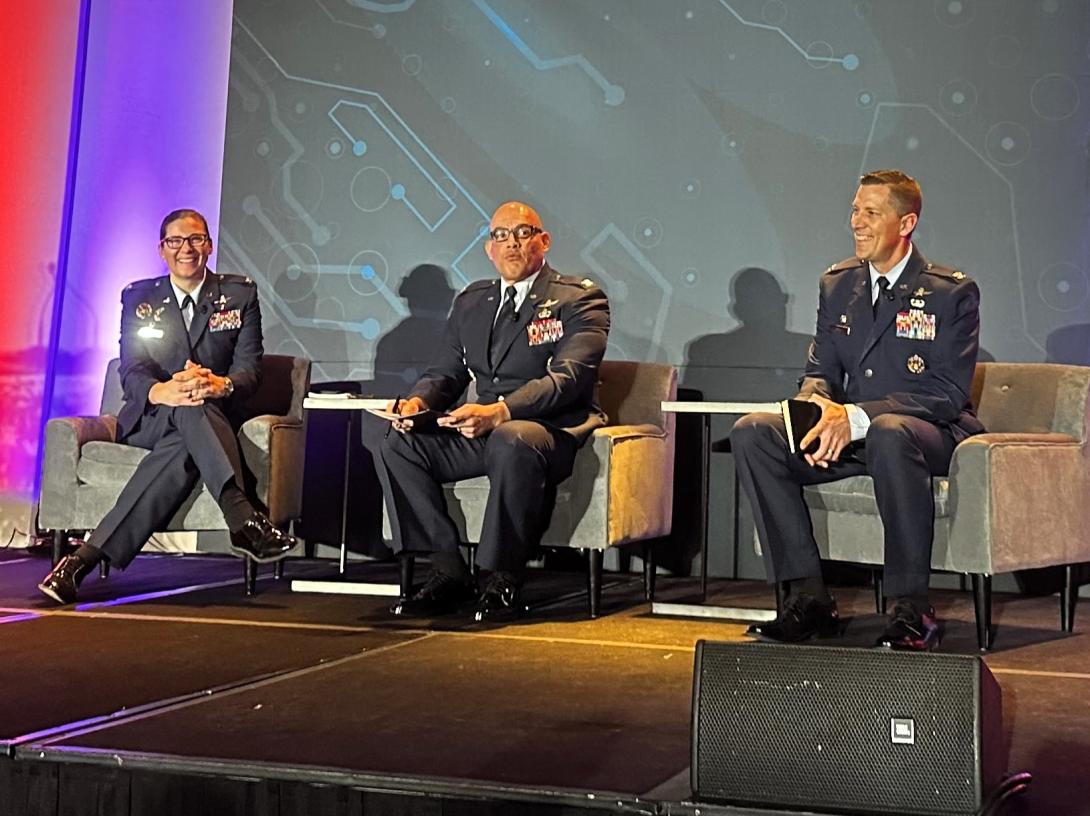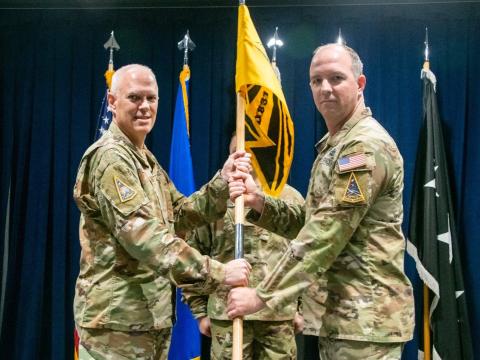Air Force’s New Airmen and Development Command Needs Evolved Training
A look from leaders into the U.S. Air Force’s training environment, including basic education priorities for airmen, technical training and operational readiness, has led to a shift in how the service is preparing its warfighters to succeed in Great Power Competition.
The evolving training priorities include shifting to a competency-based approach, examining how leaders train and making sure technical training is most productive, said Col. Lauren Courchaine, commander, 37thTraining Wing, Joint Base San Antonio Lackland, Texas; Col. Billy Pope, commander, 81st Training Wing, Keesler Air Force Base, Mississippi; and Col. Omar Velasco, deputy for communications, Directorate for Operations and Communications, Headquarters Education and Training Command, Joint Base San Antonio Randolph, Texas.
The colonels spoke to airmen and instructors at AFCEA Rocky Mountain’s Cyberspace Symposium in Colorado Springs, Colorado, on February 21.
The Department of the Air Force’s overarching effort is to transform the Air Education and Training Command (AETC) into the new Airmen Development Command, a move announced by Secretary of the Air Force Frank Kendall last week at the Air and Space Forces Association (AFA) Warfare Symposium.
Col. Pope, who overseas the technical training provided to more than 25,000 Air Force warfighters and commands 12,000 airmen and civilians that provide technical instruction to officers, enlisted and civilians, sees an urgency in getting technical training right.
“[With] Great Power Competition, we all know the relevance of Cyberspace Information Operations and that whole domain to the fight,” Col. Pope emphasized. “And I would contend that if we look forward to the 2027-2030 timeframe, the strategic advantage of our United States Air Force is in those tech training pipelines today. Those airmen and Guardians who were in cyber training today will still be on their first enlistments or their first commissioned requirements in 2027. They will be in the fight. And so it's our both opportunity and responsibility to make sure that they're ready to employ.”
For the 37th Training Wing—also known as the Gateway Wing that provides foundational training and education to develop multicapable airmen, Guardians and sister service members—instructors and students must look things in a different way, Col. Courchaine said.
“As we look at how we get after the secretary of the Air Force’s charge to optimize the U.S. Air Force and Space Force for Great Power Competition, I get the opportunity to see that from day zero,” Col. Courchaine noted. “And so many of the initiatives that we have implemented at basic military training (BMT) ... are to ensure that our airmen are prepared, even as three-level airmen to go out and focus on our adversary. Whether that's spinning a wrench, whether that's guarding the gates, or whether that's fingers on keyboards ensuring that our networks are safe and secure. It's our job as leaders to make sure that airmen understand the why, but also then have the the tools and the techniques to be successful in any endeavor that they find themselves in, as losing is not an option.”
Col. Velasco, meanwhile, manages more than 7,000 communications, information technology and cybersecurity professionals that provide capabilities and services to over 65,000 personnel across 19 wings. He sees the status quo as no longer sufficient.
“We've got to make some pretty significant moves to put ourselves in a better place to compete, and if necessary, defeat,” he stated. “Specific to what we're doing in AETC, our commander, Lt. Gen. Brian Robinson, has six LOEs [lines of effort] that are keenly oriented on building the force the nation needs. It's not just about training. It's about comprehensive force development, how we manage our talent. And … as we are going to become the Airmen Development Command, [we will] in essence, become the epicenter of all things force development.”
The main shift, Col. Velasco stated, is a move away from checking off completed tasks in training to building and measuring competencies.
“We are working to figure out how to establish ... competencies into each of our personnel,” he clarified. “That's really more about the application of what you know, your experience, your skills, your abilities, into how you use it for the execution of your job. And on a really critical day, how you use it to fight the nation's wars.”
It's our job as leaders to make sure that airmen understand the why, but also then have the the tools and the techniques to be successful in any endeavor that they find themselves in, as losing is not an option.
In addition, the command is examining the concept of “learning engineering,” delving into how they actually train and deliver content to students across the continuum of their careers, the colonel shared.
To provide a great a training environment for technical skills, Col. Pope added, sometimes it is about providing the necessities first, meetings leaders’ basic needs.
“If you're familiar with Maslow’s concepts, who was a psychologist that to reach enlightenment, that depends on all of the layers of the requirements a human has, from food and shelter to safety and security,” he clarified. “If we're going to produce the most technologically advanced airmen in the world, that doesn't mean throwing VR [virtual reality] at the problem. What it means is establishing infrastructure, HVAC, and getting people to have a comfortable place to sleep and then establishing Wi-Fi, to the power requirements of our facilities. And then you can introduce the technology. Then you can incorporate the technology in a way that's going to be operationally effective.”
Col. Courchaine and the other leaders also discussed the reputation of AETC being “too slow” to change. She emphasized that for the 37th Training Wing, the need is to provide that basic, foundational training for airmen.
“As leaders, we need to look at the words that we use,” she explained. “Because we are not ‘changing’ your curriculum, but we need to modernize the curriculum, we need to keep pace. ... But it is still basic training. I do think when we look at curriculum at AETC, there is a very good opportunity to go fast. One, it's incumbent upon all of us to know what our decision space is, know what our left and right limits are, and then start to have a conversation about where is the best place to modernize that curriculum to make that airmen more successful when they get out into the operational Air Force.”
As for how the Air Force will develop “multicapable” airmen for application in the service’s Agile Combat Employment, Col. Courchaine hopes that leaders in the new command will examine that further to delineate what exactly will be expected of airmen.
“With multicapable airmen today, we need that person to have that base level of IT skills,” she said. “It's probably not in basic military training. But it probably has something to do with how we manage the talent across the force. And I think this is an area where when we stand up the Airmen Development Command, and we truly look at the capabilities. One, what are the core competencies that we need? And then who has those core competencies? And then what should that level be to ensure that our systems across the Air Force, and not just IT systems, are the ones that we're going to need to go forward.
In basic training, there needs to be more instruction so that airmen understand the risks of social media, for example. “I think within at least within the first seven weeks, the focus is how do I get them to understand why TikTok, why all the social media [is a risk], what that is doing to the six inches between your ears, and then also what it's doing to your device,” Col. Courchaine said. “And then when you take that device places, what's happening. We got to plant the seed, and [Col.] Billy [Pope] continues to build on it, and then we figure out how we can do this in a more scalable manner across the Air Force.”
Also, Col. Pope encouraged airmen to consider becoming instructors. “I contend that you will become a better leader,” he said.





Comments